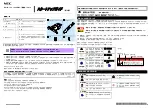
49
Connection example
of an accessory module to a connected
alarm system, e.g.: Terxon S. Note that the jumpers are all
removed and the outputs are working as relays (NC).
Inverting relay outputs
You can reprogram the relay outputs individually to work as NC
instead of NO. Reprogramming relay outputs affects all function
modes. To reprogram the relay channels, proceed as follows:
In the main programming menu, select item 5 (LED 5 lights
up).
Confirm by pressing SET.
LED 1 lights up or flashes to show output 1.
You are now in the submenu of item 5. Select the output where
the polarity is to be changed. To select the output, press
SELECT.
Confirm the selection of the output by pressing SET.
The LED of the selected output flashes or lights up.
To change the polarity of the output, press SELECT.
A constantly lit LED means that this output is programmed as
NO. A flashing LED means that this output is programmed as
NC.
After setting the polarity of the output, confirm the selection by
pressing SET. You now return to the output selection menu.
After setting the outputs, exit the programming mode by
pressing ESC/DEL.
The LED for the power supply lights up/flashes and the fault
LED lights up. The accessory module beeps at short intervals.
Close both tamper contacts of the WAM and wait until it emits
a double tone.
In this example, dip switches 2, 3 and 4 of the accessory module
are set to ON. Battery faults, supervision failure and jamming all
activate output 4 of the WAM.
First-detector recognition:
Output 1 of the alarm centre is connected to input 1 of the
accessory module. If the alarm centre is activated, this output
switches against ground (0 V) and remains so until the system is
deactivated.
After the alarm centre is deactivated, the LED of the detector
channel that was triggered first flashes on the accessory module.
LEDs on detector channels that have also triggered light constantly
on the accessory module.
















































